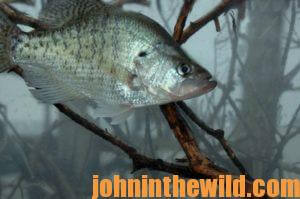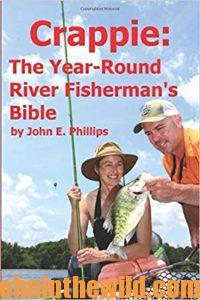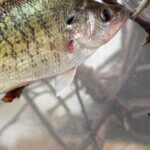Editor’s Note: During the end of March across much of the South, the weather and water will begin to heat-up. The crappie will move into the shallows near the bank to spawn. But, as often occurs at that time of year, one day when a friend of mine and I planned to fish for crappie, a late-winter cold front hit the lake. The crappie and the anglers who usually tried to catch them vanished, except for a few diehard fishermen who wouldn’t believe that spawning crappie would be affected by a severe weather change.
One of the key considerations for consistently finding crappie any time is locating vertical forms of cover and bottom structure that permit the crappie to move up and down in the water – regardless of the water temperature or the time of year. These features also may attract baitfish. For this reason, bridge pilings on the edges of creek and river channels are productive places to find crappie year-round. Besides providing the vertical feature that crappie prefer, the bridge piling also breaks the current and attracts baitfish that the crappie eat.
At different times of day and night and under various water and weather conditions, crappie will position themselves at several depths along the pilings. And, depending on the time of year and the seasonal migration pattern of crappie at that time of year, crappie fisherman may pinpoint the papermouths either on the pilings closest to the river or the creek channel or the pilings closer to the bank. However, at almost any time of year, bridge pilings provide habitat for crappie and a productive place for the crappie angler to look for fish. During fall and winter, the concrete of bridge pilings absorbs heat and transmits that heat into the water. So, often there will be a degree (or two degrees) temperature change close to that piling. In cold weather, that degree or two of warmer water may provide a hot spot for crappie fishermen.
When major impoundments are built, and the water is backed-up, all the cover and terrain features that have been on the land are submerged. Some of the best underwater, man-made structures that pay off for crappie fishermen when a lake is inundated are the underwater highways and railroad roadbeds, which provide bottom breaks that crappie and other fish hold on during different times of the year.
Often the railroad roadbeds are the most productive for several reasons, because these roadbeds were built high off the ground before the lake was impounded. Therefore, when the water rises, the roadbed is a vertical structure that crappie can hold on during any time of the year. And, since railroad tracks often cross streams and creeks, you may find old railroad trestles submerged in deep water where the crappie will hold throughout much of the year. By using a topo map that shows bottom structure and by talking to residents who lived in the area before the lake was formed, crappie fishermen can locate these old roadbeds and often locate plenty of papermouths.
Four highly-effective methods will find and catch roadbed crappie:
* Locate the edge of a roadbed on your depth finder. Place a floating-marker buoy at the point where the top of the roadbed drops-off into deeper water. Next, motor your boat 50-100 yards, either up or down the lake, locate the old roadbed again, and put out another floating-marker buoy where the roadbed slopes into deeper water. By motoring your boat in-between the buoys and watching your depth finder, you can spot schools of crappie. Once you locate a school on your depth finder, drop a buoy to mark that school. Often an angler will discover three or four schools of crappie within the 100 – 200 yards of roadbed he’s buoyed off. After buoying off the schools, return to them, and cast jigs or vertical fish for the crappie with minnows.
* Bu oy off the same 100 – 200 yards, and slow-troll crappie jigs at the depth where you’ve located the schools of fish. Although this deep-water tactic for crappie is effective all year, it seems to be most-productive during the hot summer and cold winter months.
oy off the same 100 – 200 yards, and slow-troll crappie jigs at the depth where you’ve located the schools of fish. Although this deep-water tactic for crappie is effective all year, it seems to be most-productive during the hot summer and cold winter months.
* Fish near underwater bridges and trestles for papermouth dividends. To be able to consistently catch crappie from this type of underwater structure, the angler mentally must picture the bridge before the water level has been raised. Most bridges have some type of steel support above the roadbed. When crappie are shallow, the fish often will be suspended in and around those supports. During extreme weather conditions, like the coldest or the hottest weather, the crappie usually will move lower on the submerged bridge and may hold under the bridge where it’s once crossed a creek. Many times when a jig falls right beside the old bridge and passes the roadbed, an angler can picture in his mind how the crappie run out from under the shade of that bridge and take his or her bait.
* Fish underwater bridges with concrete or steel pilings that once have supported the old bridge. These underwater pilings are just like the bridge pilings above the water, in that some of them stand on the edges of an old creek or a river bank, providing the vertical structure that crappie prefer to move up and down on when water and weather changes cause them to go more shallow or deeper. These old underwater bridge pilings also provide current breaks in which the crappie can hold. Therefore, by locating the bridges and the old rights-of-way, anglers can find plenty of deep-water structures to take crappie from all year long.
To learn more about crappie fishing, check out John E. Phillips’ book, “Crappie: The Year-Round River Fisherman’s Bible” at https://amzn.to/2mxWIt4 available in Kindle, print and for the Audible version at https://adbl.co/382m0SR.
Tomorrow: Why Fish Tall Timber for Crappie
















